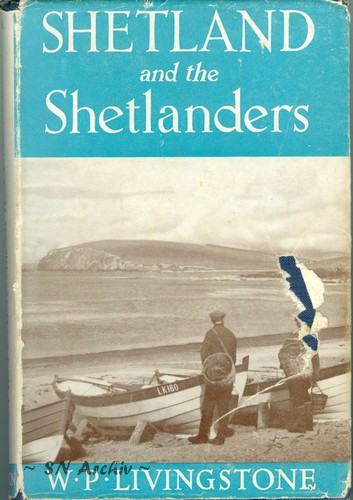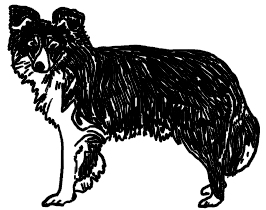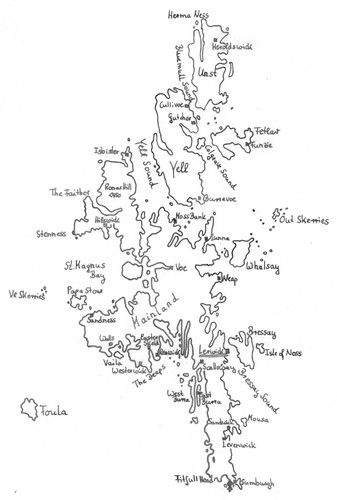 |
Shetland and the Shetlanders W. P. Livingstone, Thomas Nelson & Sons Ltd., London, GB, 1947 (1st edition) |
 A 230-page booklet with over 30 b/w photos give an insight into the Shetland Islands and the life and work of the inhabitants. It includes chapters on "The General Scene, Romance Of The Past, Yesterday And To-Day, The Cycle Of The Seasons In Croftland, Shadows Over The Isles". Even though there is no big mention of island dogs in the book, there is a photo of a Shetland Collie to admire. In my opinion, the photograph shows the young Hildasay Viking.
A 230-page booklet with over 30 b/w photos give an insight into the Shetland Islands and the life and work of the inhabitants. It includes chapters on "The General Scene, Romance Of The Past, Yesterday And To-Day, The Cycle Of The Seasons In Croftland, Shadows Over The Isles". Even though there is no big mention of island dogs in the book, there is a photo of a Shetland Collie to admire. In my opinion, the photograph shows the young Hildasay Viking.
Page 89-92: "Crofting:
Crofting has little relation to farming in the South. It is of the nature of small-holding. The methods, though simple and primitive, are not the less suited to the conditions and they entail much thought and labour.
A crofter is one who rents or owns a house and a small area of arable ground, and has the right to pasture his livestock on the hills and moorlands - the 'scattald' - which is common to all. No uniform size is fixed for a croft, it may be anything from four to six or eight acres; twelve is considered the minimum that can be worked, and thirty is the aim of the county authorities. The original croft containing the best soil is the 'infield'; ground of inferior quality that may have been added is the 'outfield'. ...
The livestock consisted of cows, sheep, and, in some cases, a horse or pony. Each croft - ... - is allowed sixty sheep in summer and fifty in winter. Naturally the numbers vary according to the circumstances of the crofter. All the crofts carried poultry, some added ducks; a few had geese and turkeys. There were no pigs or goats. ...
A crofter may thus rent two or three crofts in addition to his own. Owners of sheep, therefore, are decreasing, and the number of sheep increasing. ...
A croft is supposed to be a self-contained unit dependent on its own resources. This is true as regards labour: delving, ploughing, sowing, reaping, stock-rearing, peat-digging and all the minor task have to be done by the crofter and his family. But from early times it has never provided more than the bare necessaries of life. ...
It has therefore always been imperative to have a supplementary source of income, and the sea has provided it. ...
It follows that much of the croft work, and in many cases the whole of it, falls upon the women, who in addition contribute to the family exchequer by knitting. ...
Apart from the element of compulsion Shetlanders have a natural turn for sea life. The common saying is, 'it's in our blood.'"
Page 116: "Summer ... Dreamy Days ...
The sheep were looking untidy and uncomfortabel - their wool beginning to fall off and to trail on the ground. on 1th June the crofters, men and women, and half-a-dozen excited collies, rounded up the ewes and penned them in a 'kru,' a square concrete enclosure at the edge of the loch. Their legs were tied and the women, kneeling, swiftly plucked of the wool. 'Plucking' is hardly the right word - 'rooing' is thwat they call it locally - for the process is painless. The fleece simply came away in their hands. 'The new wool below is pushing the old off' was how one woman expressed it. Thus shorn of their coats the ewes looked as small as their lambs. The wool was twisted and thrown into kishies and vonveyed to the crofts."
Page 117: "A Lonely Land
One continued to be impressed by the solitary nature of the life. Apart from team work the crofters were much by themselves. Single figures moved about the cottages. It was rarely that anyone was met on the hills; only a crofter and his collie, now and than a woman with kishie, ...
Animal life also appeared to be solitary. In the garden there was little evidence of it. ... Most of the sheep fed alone; often only one was visible on a wide tract. They favoured heights and in the evening one could always be seen against the skyline, resting on the crest of hills and cliffs. ..."
If you discover any errors in the text that may have been caused by the transcription, please let us know for a prompt correction.

